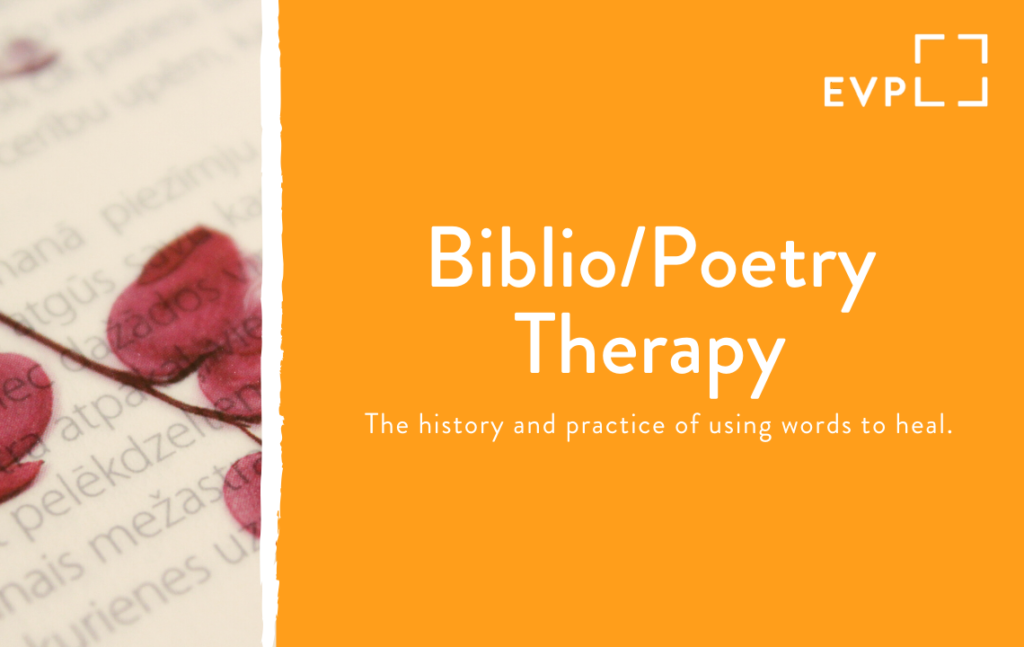Shelf Help: Can Poetry & Writing Heal?

A History of Healing with Words
The use of literature with the purpose of healing can be traced far back in human history. In the fourth millennium B.C.E in Egypt, patients would ingest a solution of words written on papyrus that was dissolved in water, in order to help cure their suffering. Soranus, a Roman physician in the first century A.D., prescribed tragedy for his patients suffering from mania and comedy for the depressed. The initial term for using books, poetry, or any literary material to help medical conditions was bibliotherapy,¹ a term coined by Samuel Crothers in 1916 in an article in The Atlantic Monthly. Librarians have also had a history of being therapeutic agents. In the 1939 book, Hospital Libraries, E. Kathleen Jones quoted two prominent hospital administrators in saying that a well-conducted hospital library is useful in expediting recovery and restoring health.² This therapeutic model evolved over time, eventually including planned discussions of readers’ personal responses to literary materials. This more interactive process or “interactive dialogue” along with adding group therapy and expressive writing created a new term, biblio/poetry therapy, in the 1960s.
What is Biblio/Poetry Therapy?
Biblio/Poetry Therapy is a type of expressive arts therapy, just like music and art therapy, which can encompass interactive bibliotherapy (the use of literature to promote mental health and wellbeing), journal therapy, therapeutic storytelling, film, performance poetry, and psychodrama.
What Are Its Benefits?
- Increased self-awareness
- Increased self-esteem, interpersonal skills, and emotional maturity
- Increased empathy and appreciation of different viewpoints, cultures, and lived experiences
- Clarification of emerging values and development of one’s ethnic/cultural identity
- Reduction of negative emotions, stress, and anxiety by practicing coping skills that provide alternative responses to problems
- Reduction of feelings of isolation by learning that others shared similar experiences (i.e. universalization)
- Finding hope from hearing how others have dealt with similar situations in a positive fashion (i.e. positive role-modeling)
- Emotional release or relief (i.e. catharsis)
What are the components of the Biblio/Poetry Therapy Model?
According to Dr. Nicolas Mazza in Poetry Therapy: Theory and Practice³, there are three components of the poetry therapy practice model, which help “address the cognitive, affective, and behavioral domains of the human experience” (17):
- Receptive/prescriptive: An individual/group reads preexisting poems/song lyrics, inviting reactions. The poem/song serves as the “springboard” so clients can discuss their personal “feelings, goals, and values” (19). A personalized, feeling response is encouraged.
- Expressive/creative: Creative writing (poems, stories, playwriting, etc.) can also be used therapeutically as a way to express emotion through concrete means and order. Journal writing is another form that can give historical perspective and connectedness. Letter writing/correspondence therapy also vents emotions giving physical and resistance distance while maximizing creative strengths or getting around limitations.
- Symbolic/ceremonial: Metaphors use symbols or images to serve as “emotions, actions, or beliefs” (21) and connect the internal and external realities. Rituals can help in validating an occurrence and promote change. They are particularly helpful with endings as they help the individual “recognize the past, let go, and move on” (22). Storytelling also helps clients externalize by creating or listening to real or fantasy stories in order to find conflict resolution.
What is the format of a typical Biblio/Poetry Therapy session?
- Entry Process: Check-in/Icebreaker activity either done verbally, through writing, or both.
- Engagement and Involvement Process: To draw out personal expression, literature selections are offered up for discussion. The purpose: to ready the mind for writing/verbal self-expression and bring rich subject material to the surface.
- Incorporation Process – Part I: Each session could allot time for writing to a prompt. Time is set aside for writing a reflection, in which the participant documents any insights or “aha!” moments, as a result of his/her/their writing.
- Incorporation Process – Part II: An opportunity to share a portion of the writing, the process, or the reflection is offered. Sharing is always optional.
- Initiative Process: Wrap-up activity to bring the session to a close.
What is the goal of a Poetry Therapist or Certified Applied Poetry Facilitator?
To provide appropriately selected literature that:
- can be collectively read and discussed interactively,
- inspires creative writing or expression, set with the intention of reflection and personal growth.
- stimulates overall creativity, which is the essence of healing.
Interested in learning more?
Check out the following links:
- The International Federation for Biblio/Poetry Therapy: https://ifbpt.org/
- The National Association of Poetry Therapy: https://poetrytherapy.org/
- “Bibliotherapy: The Healing Power of Words” by Kate Jackson, Social Work Today: https://www.socialworktoday.com/archive/111516p10.shtml
- Health Professions Network on Poetry Therapists: https://hpnonline.org/services/poetry-therapist/
Notes:
¹ https://poetrytherapy.org/index.php/about-napt/history-of-napt/
² Jones, E. Kathleen. Hospital Libraries. Chicago, American Library Association, 1939. (Out of print.)
³ Mazza, Nicholas. Poetry Therapy: Theory and Practice. Routledge, Taylor & Francis Group, 2017.



